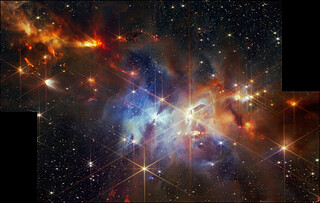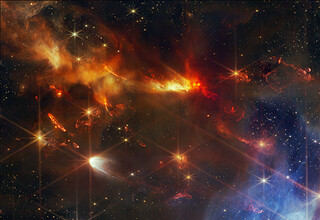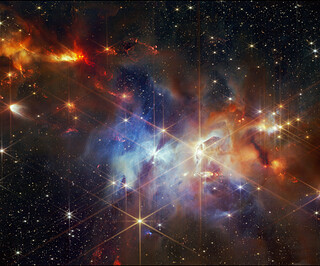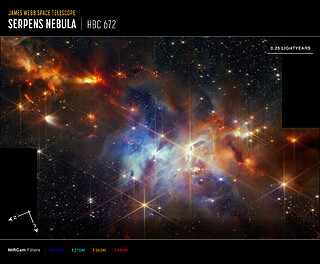weic2415 — Photo Release
First of its kind detection made in striking new Webb image
Alignment of bipolar jets confirms star formation theories
20 June 2024
For the first time, a phenomenon astronomers have long hoped to image directly has been captured by the NASA/ESA/CSA James Webb Space Telescope’s Near-InfraRed Camera (NIRCam). In this stunning image of the Serpens Nebula, the discovery lies in the northern area of this young, nearby star-forming region.
The astronomers found an intriguing group of protostellar outflows, formed when jets of gas spewing from newborn stars collide with nearby gas and dust at high speeds. Typically these objects have a variety of orientations within one region. Here, however, they are all slanted in the same direction, to the same degree, like sleet pouring down during a storm.
The discovery of these aligned objects, made possible only by Webb’s exquisite spatial resolution and sensitivity at near-infrared wavelengths, is providing information about the fundamentals of how stars are born.
So just how does the alignment of the stellar jets relate to the rotation of the star? As an interstellar gas cloud collapses in on itself to form a star, it spins more rapidly. The only way for the gas to continue moving inward is for some of the spin (known as angular momentum) to be removed. A disc of material forms around the young star to transport material down, like a whirlpool around a drain. The swirling magnetic fields in the inner disc launch some of the material into twin jets that shoot outward in opposite directions, perpendicular to the disc of material.
In the Webb image, these jets are identified by bright red clumpy streaks, which are shockwaves caused when the jet hits the surrounding gas and dust. Here, the red colour indicates the presence of molecular hydrogen and carbon monoxide. Webb can image these extremely young stars and their outflows, which were previously obstructed at optical wavelengths.
Astronomers say there are a few forces that potentially can shift the direction of the outflows during this period of a young star’s life. One way is when binary stars spin around each other and wobble in orientation, twisting the direction of the outflows over time.
Stars of the Serpens Nebula
The Serpens Nebula is only one or two million years old, which is very young in cosmic terms. It’s also home to a particularly dense cluster of newly forming stars (around 100 000 years old) at the centre of this image, some of which will eventually grow to the mass of our Sun.
Serpens is a reflection nebula, which means it’s a cloud of gas and dust that does not create its own light but instead shines by reflecting the light from stars close to or within the nebula.
So, throughout the region in this image, filaments and wisps of different hues represent reflected starlight from still-forming protostars within the cloud. In some areas there is dust in front of that reflection, which appears here in an orange, diffuse shade.
This region has been home to other coincidental discoveries, including the flapping 'Bat Shadow', which earned its name when 2020 data from the NASA/ESAHubble Space Space Telescope revealed it to flap, or shift. This feature is visible at the centre of the Webb image.
Future studies
The stunning image and the serendipitous discovery of the aligned objects are actually just the first step in this scientific programme. The team will now use Webb’s NIRSpec (Near-InfraRed Spectrograph) to investigate the chemical make-up of the cloud.
Astronomers are interested in determining how volatile chemicals survive star and planet formation. Volatiles are compounds that sublimate, or transition from a solid directly to a gas, at a relatively low temperature — including water and carbon monoxide. They’ll then compare their findings to the amounts found in protoplanetary discs of similar-type stars.
These observations were made as part of the Webb General Observer programme 1611 (PI: K. Pontoppidan). The team’s initial results have been published in the Astrophysical Journal.
More information
Webb is the largest, most powerful telescope ever launched into space. Under an international collaboration agreement, ESA provided the telescope’s launch service, using the Ariane 5 launch vehicle. Working with partners, ESA was responsible for the development and qualification of Ariane 5 adaptations for the Webb mission and for the procurement of the launch service by Arianespace. ESA also provided the workhorse spectrograph NIRSpec and 50% of the mid-infrared instrument MIRI, which was designed and built by a consortium of nationally funded European Institutes (The MIRI European Consortium) in partnership with JPL and the University of Arizona.
Webb is an international partnership between NASA, ESA and the Canadian Space Agency (CSA).
Image Credit: NASA, ESA, CSA, STScI, K. Pontoppidan (NASA’s Jet Propulsion Laboratory), J. Green (Space Telescope Science Institute)
Links
Contacts
Bethany Downer
ESA/Webb Chief Science Communications Officer
Email: [email protected]
Ninja Menning
ESA Newsroom and Media Relations Office
Email: [email protected]
About the Release
| Release No.: | weic2415 | |
|---|---|---|










